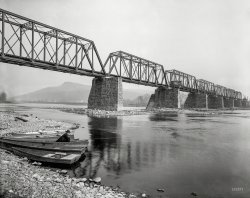
MAY CONTAIN NUTS

Search Shorpy
SHORPY ART

Framed or unframed, desk size to sofa size, printed by us in Arizona and Alabama since 2007. Explore now.
Join and Share
Ad-Free Shorpy
Shorpy is funded by you. Patreon contributors get an ad-free experience.
Learn more.

Recent comments
- Freeze Frame
- Texas Flyer wanted
- Just a Year Too Soon
- WWII -- Replacing men with women at the railroad crossing.
- Yes, Icing
- You kids drive me nuts!
- NOT An Easy Job
- I wonder
- Just add window boxes
- Icing Platform?
- Indiana Harbor Belt abides
- Freezing haze
- Corrections (for those who care)
- C&NW at Nelson
- Fallen Flags
- A dangerous job made worse
- Water Stop
- Passenger trains have right of way over freights?
- Coal
- Never ceases to amaze me.
- Still chuggin' (in model form)
- Great shot
- Westerly Breeze
- For the men, a trapeze
- Tickled
- Sense of loneliness ...
- 2 cents
- Charm City
- What an Outrage
- Brighton Park
Member Photos
The Shorpy
Print Emporium
Print Emporium
Search Shorpy
Search results -- 30 results per page
- The Old Mill: 1899
- ... Streetview.
(The Gallery, Boats & Bridges, DPC, Railroads) ... Posted by Dave - 05/25/2017 - 11:25am -
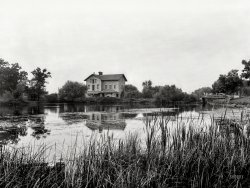
- Tumbler: 1910
- ...
(The Gallery, Boats & Bridges, Cleveland, DPC, Railroads) ... Posted by Dave - 07/30/2012 - 11:03pm -
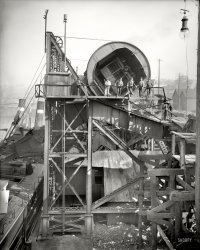
- Banana Boat: 1903
- ... 1970.
(The Gallery, Boats & Bridges, DPC, New Orleans, Railroads) ... Posted by Dave - 07/19/2012 - 4:39pm -
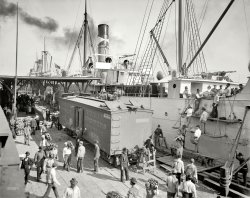
- Emporia Junction: 1943
- ... early spring wind blowing.
(The Gallery, Jack Delano, Railroads) ... Posted by Dave - 12/06/2014 - 1:28pm -
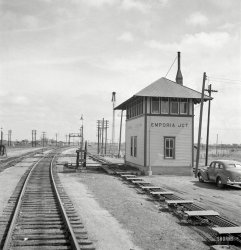
- Lake Front Depot: 1899
- ... from Y2k compliance.
(The Gallery, DPC, Milwaukee, Railroads) ... Posted by Dave - 03/15/2018 - 6:59pm -
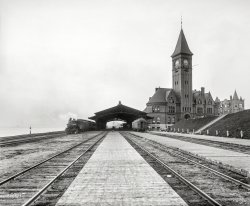
- Railyard Rollers: 1905
- ... clearings.
(The Gallery, Boats & Bridges, DPC, Railroads) ... Posted by Dave - 08/08/2012 - 2:50pm -
![Railyard Rollers: 1905 Gulfport, Mississippi, circa 1905. "New Orleans supply yard, Union Naval Stores. Shipment of rosin and turpentine." 8x10 inch glass negative. View full size.
Can't get enough turpentine photos!The gum naval stores industry as practiced before WWII is now mostly forgotten, but was once a Really Big Deal in the longleaf pine belt that stretched from North Carolina to the Gulf coast of Texas. Sadly, most of the longleaf pines are gone now, and several species dependent on the pine forests-- for instance, the ivory-billed woodpecker-- are gone for good.
Those barrels would have been made and filled with turpentine and rosin distilled in small batches at camps located way out in the piney woods, by men working under absolutely medieval conditions. The ones working to pay the company store were lucky compared to the ones who were convicts leased from local law enforcement.
I've seen most of the more widely available turpentining images, but this is a new one on me-- thanks for running it, Dave.
LunchtimeThere appears to be a lovely young lady bringing some lucky gentleman his lunch bucket, and much prestige from his comrades.
Hard labourfor those guys. It looks hot after maybe some recent rain, the barrels sure look heavy and there's a few hours left yet. Looks like there's refreshments being bought over by the youngster on the right.
Thanks for the info Thad, I never knew about turpentine's origin such as shown above.
Even the Lionel Lines1950s model barrel loader was more mechanized than this.
WWWaaa - ter boo-ooyyyBring the buck-buck-bucket here!
I remember that song so well, I could hear it in my mind when I saw this detail.
Never thought abut how rail cars wereloaded by hand before. The sunken rails, two men on a barrel, wooden rails to roll them on, all fascinating!
Safety firstThe bridges over the rail trench are noticeably lacking proper railings. 1 safety demerit!
Good, I'm starved.Here comes lunch!
As far as the eye can seeJust how many hundreds of thousands of barrels of rosin and turpentine could possibly be needed? And for what purpose, painting?
[Used in the manufacture of soap, paper, paint and varnish. More on the "naval stores" industry, and the origin of the term. - Dave]
Turpentine Forests
Washington Post, Sep 15, 1902.
Turpentine Forests.
Their Rapid Destruction Threatens the Ruin of a Great Industry.
From the New York Commercial.
The first organization of turpentine men, known as the Turpentine Operators and Factors' Association, which recently held its first annual convention in Jacksonville, Fla., was confronted by the question of complete annihilation of their business, due to the ruthless tapping of young trees and the rapid depletion of the pine forests. Ten years ago Norfolk, Va., was the great naval stores port of the United States, five years ago Charleston was the center of the industry, two years ago Savannah, and now Jacksonville, and next Tampa and then — what? Prof. Herty, of the United States Department of Forestry, has been called upon and was present at the convention.
Newspapers in the South have presented able articles on this same subject for years, but the writer has seen young trees no thicker in diameter than eight inches boxed; once, twice, yes three times, so that a step ladder was used for the top boxing and the strip of bark left was insufficient to gather the sap to feed the tree. The life of a turpentine tree after the first boxing is about two years. That means that after the sap has been taken the third time the tree must either be cut for timber or it dies. A trip through the pine forests of Georgia and Florida will demonstrate the reckless manner in which the boxing has been done, and, worse still, where clearings have been made, no effort has been made to check the growth of scrub oak and saw palmetto which effectually choke the young pine rearing its head where its parent stood. Gradually the operators have been driven south, and to-day it is estimated that at least one hundred camps are located in Florida alone, and about fifty camps in Georgia.
Nine hundred operators were at the convention. Each man has either bought or covered with options more or less pine forest, and in spite of his knowledge of what the future will bring is rapidly killing the goose with the golden egg. The end is near in the turpentine and rosin industry. A few more years will see a tremendous rise in these commodities, and no effort has yet been made to restore the depleted forests of Virginia, Georgia, Alabama, North Caroline, or Northwestern Florida. The "fat pine" is indigenous to these States, it grows rapidly, but is easily exterminated by the more sturdy plants which spring up in the forest clearings.
(The Gallery, Boats & Bridges, DPC, Railroads)](https://www.shorpy.com/files/images/4a17950a.thumbnail.jpg)
- Train Wreck: 1900
- ... indeed, built with blind lead drivers.
(The Gallery, Railroads, Wright Brothers) ... Posted by Dave - 01/12/2018 - 10:26pm -
![Train Wreck: 1900 1897-1901. "Cincinnati, Hamilton & Dayton R.R. train wreck below Dayton, Ohio." 4x5 glass negative attributed to Wilbur and/or Orville Wright. View full size.
CounterintuitiveThough not standard construction, quite a few 4-6-0 and 4-8-0 type engines, such as we are herein viewing from underneath, were built with blind leading drivers, as it was felt that the four wheel leading truck provided sufficient stability to obviate flanges on them, even at high speed.
Omitting this flange allowed the locomotive to better negotiate very sharp curves and turnouts at slow speed in yards and enginehouse areas.
Lack of this flanged driver was not a factor in this "head-on" collision. This was the result of a dispatching error or of misinterpretation by one of the engineers of the timetable or of the dispatchers instructions.
It's truePeople DO love to stare at a train wreck.
3 ThingsThere are three things I noticed. The blind drivers (no flanges) are on the leading drive axle. All the ones I've seen would have been on the center axle.
The monkey wrench laying next to the rail is identical to the one I have that came from The Milwaukee Road many decades ago.
The joint bolts in the rail have the nuts all on the same side. Standard practice now is to alternate sides. I assume the idea is to prevent them from all being sheared off by a derailed wheel. The bolt heads are a button type that a wheel would slide past without damage.
Is This Not Their Father's Wreck?Isn't this the October 20, 1897 wreck between the southbound Toledo and Cincinnati Express, and the northbound freight 30 of the Cincinnati, Hamilton, and Dayton on board which was Bishop Milton Wright, the father of the famous Wright Brothers? See this.
Front drivers were never blindOnly some very early rigid framed 4-4-0's of the mid 1800s experimented with using blind front drivers to negotiate sharper curves. It was not a practice continued on other locomotives as swinging pilot trucks would not keep a blind front driver on the rails.
On larger engines in the early 1900's blind center drivers were used but in following years better lateral motion devices and improved track geometry all but ended the practice. Once a locomotive was well wore in it was still possible to drop a blind center driver off the rails on a sharp curve and many locomotive rebuilds included putting flanged tires back on.
More than likely in this instance in the moments preceding the wreck the brakes were applied sufficiently to heat up the tires on the locomotive which expanded them and they have come off the wheels. As you can see the side rods have been removed and likely the loose tires from the front axle have been removed or broke during the wreck.
Monkey wrenchI also have a monkey wrench like the one that Alan spotted. It is all forged and machined. The adjuster has square threads and the wooden handles were hand fitted as well as if they were done by a gunsmith. Modern tools do not compare.
A Line of ____Upper right background, there is a line of objects giving the appearance of a string of box cars. Small cabins, maybe?
[Looks like a split-rail zigzag fence. -tterrace]
This is also trueWhile it is evident that the side rod on the upper side of the lead driver set was sheared off in the collision, the lower side shows no sign that anyone made any effort to remove the side rod nor the tire. Engines were, indeed, built with blind lead drivers.
(The Gallery, Railroads, Wright Brothers)](https://www.shorpy.com/files/images/SHORPY-00520a.thumbnail.jpg)
- Over the Oconee: 1941
- ... - Dave]
(The Gallery, Boats & Bridges, Jack Delano, Railroads) ... Posted by Dave - 02/17/2019 - 3:32pm -
![Over the Oconee: 1941 November 1941. "Greene County, Georgia. Railroad tracks across the Oconee River." Medium format negative by Jack Delano. View full size.
What Are the Odds?Like many others, my first speculation at seeing the barrels along the tracks was that it was in case of fire, but why would a train be more prone to catch fire on a bridge, as opposed to solid ground tracks?
[Um, they're worried about the tracks and the bridge catching fire, not the train. - Dave]
Shouldn’t there be water barrels all along railway lines if the danger of fire was so prevalent? Also, just having a bucket to attempt to propel water on the burning locomotive would be an act of futility indeed, given the limited draw of water from the barrels. A man could only draw about a half of a full barrel effectively before the water level became difficult to reach. The collective spitting on the blaze by crew - and passengers, should there be any - might be just as effective. I’m sure other group efforts to extinguish a blaze come to mind, do they not, gentle reader?
Another reader questioned if the railway was elevated. If it isn’t, I bet those knee high telegraph lines to the left afforded a lot of problems of their own: cattle getting tangled up in them; local kids playing on them; you know, typical stuff.
Fire causes: embers falling or flying sparksBy the end of the 19th century wooden bridges in Europe and North America were generally replaced by iron constructions. High maintenance costs of the uncovered bridges and several fires due to embers falling or flying sparks from the engine banned wood as a construction material for bridges in the guidelines of several railway companies, restricting it to branch lines only.
Quote from The Influence of the German Railways on the Birth of Modern Timber Engineering
Click here to view a wooden bridge collapsing caused by a fire.
P.S. Many commenters put questions that are already put, or even answered. So my advice: "Read below the lines."
[That's not why all the comments are asking the same question, Alex. Maybe you can figure it out! - Dave]
Guard railsI think that the two sets of guard rails serve a slightly different purposes. LarryDoyle is right that the outer set (call 'em "timbers" if you like) is unusual in design and look like they are meant to stop a train from sliding laterally off the bridge.
The inner set serves a different purpose, though. Their main function is to support the weight of a derailed train and to spread that weight out over multiple ties to avoid a structural failure. The wheel flanges on a heavy locomotive or train car are essentially rotating blades, with all of the train's weight on a series of 1" long chisel-shaped curved spines, which could easily chew through a wooden tie, particularly if a series of wheels passes over the same spot as a moving train derails. These guard rails support the axles or whatever part of the truck comes to rest on them, and spreads the weight over the structure so that the ties don't give way and train doesn't fall through the bridge or hit its structural parts.
If the inner rails were truly meant to stop lateral movement, they would (should?) have been affixed to the ties with proper chairs or base plates, and have been closer to the running rails, maybe 1.5" or 2" away. You can see what I mean in the picture below, from https://en.wikipedia.org/wiki/Independent_Subway_System#/media/File:BMT_100_Nostalgia_Ride_(19329819685).jpg. There is a guard rail in the middle of the tracks, and a "keeper rail" close to the inside running rail. The keeper rail pushes back on the wheel flange if the trail starts to derail, and forces the truck back into alignment with the curve. Note how strongly it's affixed to the main rail and the track bed.
The barrels of waterare for a fire, and the inside set of rails so the train does not fall off the bridge on derailment, I've often wondered was ever a bridge saved by those barrels?
Now Lake OconeeThis appears to be just east of the railroad bridge over the Oconee River with the Carey Station Road crossing in the distance.
Guard RailsIv'e never seen a bridge with "guard rails" arranged like this one.
In the middle of each triad of rails are the two running rails, which are really the only rails that you ever really want to use when running a train. The other four rails are for safety in case of a derailment.
The innermost pair of the six rails seen are guard rails, nearly always found on bridges, spaced about 6" from the running rails so that a derailed wheelset would drop into the space between them and be held from rolling sideways and going off the side of the bridge.
The outermost pair of rails are called guard "Timbers" and serve the same purpose as the inner guard rails. Can't have too much safety. The guard timbers are usually just that - timbers bolted to the ties. this is the first time I have ever seen old rails tipped on their side and used as guard timbers. Unusual.
A lot going on hereI'm anxiously waiting for an expert to explain what the features are for beyond the track and ties. Are those burn barrels for lights?
Dual useThat's an interesting configuration. A narrow gauge rail on the same ties as the main line.
Questions Questions QuestionsOK, what gives with the multiplicity of rails, the "sideboards," and all the barrels? Looks like this section of track is elevated, or is that an illusion? Flood plain?
BarrelsI suppose, from the absence of a lid, those are water (not sand) barrels for fire suppression from stray embers. Inside would be a bucket with a rounded bottom so as to make it useless for households.
Otherwise wooden trestles would be always burning down.
Tough on litter?Why are there so many trash cans?
Barrels and tracks?Okay, railroad buffs: What are the barrels for? And I would think that the tracks are set for two directions, two rails and an electric line for each direction, but obviously not in use at the same time... Yes?
Barreling along the track.Okay all you railroad buffs, I'll bite.
What are the barrels for? Do they hold sand for rail traction in the winter? For fire in case the trestle catches fire?
Also, why the double sets of rails and what are the outboard uprights for?
Water Barrels? Are the barrels there for water in case the trestle catches fire?
Just CuriousWhat are the barrels for? Anybody know?
[They're full of peach pits and cigar butts. - Dave]
(The Gallery, Boats & Bridges, Jack Delano, Railroads)](https://www.shorpy.com/files/images/SHORPY-8c07604a.thumbnail.jpg)
- Tank & Barrel: 1903
- ... when rolling.
(The Gallery, DPC, Florida, Pensacola, Railroads) ... Posted by Dave - 10/02/2016 - 5:59pm -
![Tank & Barrel: 1903 1903. "Plant of the Consolidated Naval Stores Company, Pensacola, Florida. Resin and turpentine." 8x10 inch dry plate glass negative. View full size.
WiredAny idea about the wires surrounding the tank? Lights? Lightning rods?
Where are the signs? There should be about 100 "No Smoking" signs plastered all over the site.
Wooden barrels (dry and aged, from appearance) filled with turpentine, or pitch, and heated in the sun and exuding all sorts of aromatics, the site is a fire hazard awaiting the match.
Given that Florida is the "Lightning Capital of the World", I would suspect the conductors are for lightning dissipation. If the array had been a bit closer, I would have thought it might make a Farady Cage, which would be an excellent lightning protector. As it is, circling the top, and repeating the circle down the side of the tank multiple times, there is a conductor to ground close at hand for lightning to connect with surrounding the tank. Only question I have is that the diameter of the wire is so small, and would likely vaporize if it had to pass common lightning amperage.
The lightning protection wires on a 100-year newer building(well, 90)in Atlanta at the 20th+ floor were almost the diameter of a large "Magic Marker" tube, a common office item for comparison. That shown appears to be common barbed wire, not the 'thumb size' of modern conductors.
Sacrificial barrels on storage barn It appears the half-dozen or so barrels on the peak of the roof of the building in the background are decoys for lightning. Here in GA, we have decoy trailer parks for tornadoes to scatter, leaving the real ones untouched. I suspect both work just as well at their task.
Roof BarrelsThose barrels on the ridge of the roof are water-filled, and very effective, immediate fire extinguishers. We saw these mounted on sawmills here until the 1960s. In the era of self-sufficiency, these were about state of the art.
I think your sacrificial trailer parks are probably just a placebo for your community, but these barrels were very much on the front line of fire protection.
[A lot of these rooftop barrels and pails were filled not with water but sand. - Dave]
I suppose sand would be a better choice in some instances. But, I'd rather pump up water than lug up sand!
Where there's pine, there's turpentineThe pine forests of the southern US were the main source for turpentine and "naval stores" during the late 19th and early 20th century. Southeast Texas provided its share of pine trees to the naval stores market, to the point that a town in Jasper County was named Wenasco [trade name for the Western Naval Stores Company].
Cheap railroad?Can anyone address the two parallel lines of wooden boards down the middle of the barrel storage area? An inexpensive "railroad" for carts carrying barrels, perhaps?
Barrel trackThe barrels, owing to their shape, will self-center and roll the length of the 'track'. Thus no cart is necessary. So 'roll out the barrel, we'll have a barrel of fun' (as the song says).
The barrel shape with a 'belly' also made them much easier to turn when on their sides because of the narrow contact patch one person could easily roll them around.
Newer steel and plastic drums are primarily designed for handling with carts or lifts and depending on weight can take a couple people to get them to turn when rolling.
(The Gallery, DPC, Florida, Pensacola, Railroads)](https://www.shorpy.com/files/images/SHORPY-4a10773a.thumbnail.jpg)
- A Fork in the Railroad: 1943
- ... closed side of the frog.
(The Gallery, Jack Delano, Railroads) ... Posted by Dave - 05/04/2013 - 3:05pm -
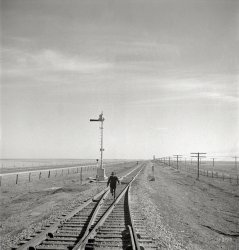
- Mightiest Electric: 1924
- ... same.
(Technology, The Gallery, D.C., Harris + Ewing, Railroads) ... Posted by Dave - 08/05/2014 - 3:07pm -
![Mightiest Electric: 1924 June 1924. Washington, D.C. "Largest and most powerful electric locomotive in the world being exhibited by the Chicago, Milwaukee & St. Paul Railway and the General Electric Co." Harris & Ewing Collection glass negative. View full size.
Monarch of the Rails
Washington Post, June 25, 1924.
Free Exhibit
Giant Electric Locomotive
Don’t fail to see this Monarch of the Rails—the pride of the “Milwaukee” road at New York and Florida Avenues, Washington, Wednesday June 25 and Thursday June 26.
These mighty electric locomotives, made by the General Electric Co., haul the Olympian and Columbian, famous Trans-Continental trains, silently, smoothly and speedily for 649 miles over the Rocky, Bitter Root and Cascade mountain ranges. Steps and platforms will be erected to enable visitors to go through the interior and a staff of well informed representatives of the C. M. & St. P. Ry. and General Electric Co will be in attendance to explain details. Admission Free. To Puget Sound—Electrified.
Proud to be "Bipolar"The five Milwaukee Road Class EP2 bipolar electric locomotives ran from 1919 to 1961, with a major rebuild in 1953. One has survived and is on display in St Louis. Amazing beasts.
Bipolar locomotivesThese locomotives used an unusual transmission system, which is to say, none whatsoever. The rotor and the wheels were mounted on the same axle, so that the whole thing moved up and down together. The arrangement was very quiet and avoided wear on driving gears or rods; the drawback was that there could only be two stator poles, so each motor was relatively low powered compared to what was achieved with more conventional motors. Every axle you see is driven except for the ones on either end directly behind the pilots. They were articulated seven ways from Sunday, with four trucks supporting three body sections.
One survives, in St. Louis.
Steamless in SeattleYes, the "Milwaukee Road" ran electrics to the Pacific Northwest from the early 1920s up to the early 1970s.
"...When these sections were placed in full electrical operation (Harlowton [MT] to Avery [ID] in 1917 and Othello [WA] to Tacoma [WA] in 1920) they represented the first long-distance electrification in North America and were the longest electrified lines in the world. "
Unfortunately, they never completed the gap between the two electrified routes (Avery to Othello). The electric locomotives were phased out and supporting infrastructure removed--just before the 1973-74 oil crisis (!)
See this article.
1953 RebuildDuring the rebuild of 1953 the Milwaukee bought 12 EF-4 and EP-4 replacements from GE. The 12 were part of an original order of 20 ordered by Stalin and bound for the Soviet Union but with the Cold War increasing the sale was blocked. The Milwaukee offered to buy all 20 from GE but it's BOT refused to go along but ultimately the Korean War and a coal strike led the BOT to approve the purchase. The irony was that Milwaukee first offered $1M for all 20 locomotives and spare parts but when finally allowed to buy the units only 12 still remained but the price remained the same.
(Technology, The Gallery, D.C., Harris + Ewing, Railroads)](https://www.shorpy.com/files/images/SHORPY-32400a.thumbnail.jpg)
- Western Union: 1931
- ... on the right.
(The Gallery, Irving Underhill, NYC, Railroads) ... Posted by Dave - 06/16/2013 - 8:39am -
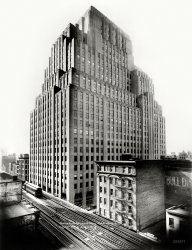
- Ironmen: 1905
- ... smokestack.
(The Gallery, A.P. Godber, New Zealand, Railroads) ... Posted by Dave - 06/01/2014 - 12:21pm -
![Ironmen: 1905 Petone Railway Workshops circa 1905. H class steam locomotive, 0-4-2T type, for use on the Fell system on the Rimutaka Incline. NZR 199 built at Avonside Railway Workshops in 1875, went into service on the Rimutaka Incline in January 1877, written off and preserved in March 1956.
One of more than 2,000 train-related glass negatives, now in the collections of the Alexander Turnbull Library, taken by New Zealand Railways employee and amateur photographer Albert Percy Godber (1875-1949). View full size.
Sure built them wellI'd have to say, 79 years of service is pretty remarkable.
Personal BestI've been in service since 1934 -- that's 80 years!
Lumpy LocoAll the sheet metal looks shiny and smooth except for the cab sidewalls. It looks as if it was attacked by a massive hailstorm, or did the crew have a coal-throwing melee?
[Parking lot door-dings. - Dave]
Service LifeIf you have a machine shop and a foundry, you can keep a locomotive like that going practically forever. Of course, after a long enough period, the only original part on it might be the number plate.
Double StacksA feature normally seen only on locomotives with four cylinders and double sets of drivers: mallet, simple articulated, or beyer-garret types, all of which are far larger than this tank engine. In this case each cylinder had its own exhaust nozzle. Strange. Well maintained machine, I give it that.
H classWikipedia has the history. The reason that the H class lasted 79 years was because they were unique; using the Fell system to propel trains over a 1:15 incline. The end came in 1955 when the Rimutaka tuneel was built.
Much more to discoverThe Loco has Stepenson gear - not uncommon 1875, but almost obsolete in 1956. The Loco seems to be under steam. It seems, that steam is coming out a source in front of the cab. Has anyone here seen a H class from near: Is there a safety valve or any other steam outlet on this place? Near a working safety valve nobody would stood so relaxed.
80 Years of service is for a well-maintained steam loco not uncommon. In Germany (Isle of Ruegen) there are several engines this age still in all days use, and in Romania (I've been there several times in the 90's) I also met engines built by Krauss Linz in the 1890's.
The dents in the cab could come from something rude loaded fuel.
Dents in cabAfter thinking long and hard, I came to the conclusion that the dents in the cab side panels were put there deliberately to stop the panels vibrating when the loco reached speeds that achieved resonance in them. Imperfections such as dents break up resonances in large flat panels.
Long service lives, double stacks...79 years in service is nothing unusual for a steam loco outside the US. When I started my apprenticeship I was working on engines that were all close to 100 years old. As ElViejo notes, if you have a well-equipped, well-staffed workshop you can keep them going for a long, long time.
As for the double smokestacks, Lost World is incorrect in saying that only 4-cylinder articulated engines were normally fitted with these. Many modern rigid engines in the US and the rest of the world had them, to improve draughting and reduce cylinder back pressure. Union Pacific 844 is a good example. And as for Garratts, the only examples to have double smokestacks were the Algerian passenger Garratts, and the related engines in Senegal and the Ivory Coast, all built by Societe Franco-Belge. All other Garratts had single stacks.
H199 has double stacks because it has two independent sets of cylinders, one for the adhesion engine, and one for the Fell system grip wheels. Each set of cylinders had it's own blastpipe and smokestack.
(The Gallery, A.P. Godber, New Zealand, Railroads)](https://www.shorpy.com/files/images/SHORPY-FL16666350.thumbnail.jpg)
- Elmhurst Depot: 1899
- ... at www.winnetkahistory.org )
(The Gallery, DPC, Railroads) ... Posted by Dave - 12/09/2016 - 1:50pm -
![Elmhurst Depot: 1899 Circa 1899. "Chicago & North Western Railway station, Elmhurst, Ill." 8x10 inch dry plate glass negative, Detroit Publishing Company. View full size.
Another Left Handed RailroadThe Duluth Missabe & Northern, later incorporated into the Duluth Missabe & Iron Range, now part of the Canadian National, also considered itself to be a left hand railroad. On double track, trains ran on the left hand track, and all signals were placed to the left - even on single track. Some of these signals still remain.
Tie PlatesThere are no tie plates to spread the load of the rails to the crossties (sleepers to our European friends). Some of the ties look the worse for wear because of this. According to Wikipedia, tie plates came into use around 1900, just about the time of this photo.
It izIt is indeed the tap for the circuits into the station; but a bit more than that. I can see five lines which can be opened - see the insulators on bars, so the wire comes in from (say) the east, runs into the station, comes back out, and heads west. That is, the wire is not continuous past the station, but both sides go into the station.
I would expect that the box contains primary lightning arrestors for each wire dropping into the station; secondary arrestors may be in the station.
With this arrangement, circuits can be patched from one wire position to another. Also remember that telegraph was the usual communication system at the time of this picture.
It iz....answersignalman,
Thank you for the info! Makes sense now. I wonder if the 'thick' wire is just a thick ground or contains the two lines headed down to the station. I would think it as a ground as it is just too thick for two small lines.
WhatizitSo my family and I have extensive telephony background, and personally I have that and railroad background, but still, what is the item on the telephone crossarm that looks to be rectangular, about 3 feet long with a pitched roof with one thick cable exiting the bottom? Is there a name for this and what is its purpose?
I agree there are lines going from the insulators into it, so it may be some sort of permanent tap for the stations telegraph/telephone. Even so, seems to be overdone for a simple splice.
As a child I used to take the train there... on Saturday mornings in the winter to play ice hockey at the YMCA several blocks away. Where did those fifty years go?
A Scratch-builder's ParadiseIf you model train scenes, in any gauge, this picture is a veritable goldmine! Such wonderful details would keep the poor modeler busy for many a snowy evening. Positively stunning. Keep up the good work.
Left-Handed Train Operations on the C&NW RailwayIn the deep background you can just make out two trains that illustrate one of the most peculiar features of the Chicago & North Western Railway, the fact that its trains operate on the left hand track, rather than the right hand track. This practice continues to this day, which makes the C&NW (now part of the Union Pacific system) the only left-handed railroad in the USA. The explanation for this unusual practice usually goes like this:
"The first component of what was to become the Chicago & North Western Railway was the little Galena and Chicago Union Railroad Company. Tracks were laid west from Chicago to Geneva, where the first station was to be built. The company built the station on the north side of the tracks where most of the people lived. This saved passengers the inconvenience of having to cross the tracks to go home.
When traffic required double tracks, the only place to lay new rails was south of the original single tracks. Since the stations were used primarily by passengers waiting to travel into Chicago, the company decided to run east-bound trains on the old track so riders would not have to cross the tracks to board—a dangerous process." (From Tom Hermes, "Why Does Our Train Run on the Wrong Track?" Winnetka [Illinois] Historical Society Gazette, Fall 1996, reprinted at www.winnetkahistory.org)
(The Gallery, DPC, Railroads)](https://www.shorpy.com/files/images/SHORPY-4a04072a.thumbnail.jpg)
- Saranac Lake: 1905
- ... a back-up method of lighting.
(The Gallery, DPC, Railroads) ... Posted by Dave - 04/19/2018 - 7:08pm -
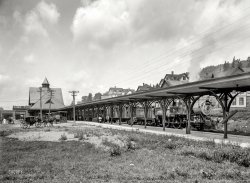
- Scollay Square: 1905
- ... in the history of Boston.
(The Gallery, Boston, DPC, Railroads, Streetcars) ... Posted by Dave - 06/30/2014 - 10:59am -
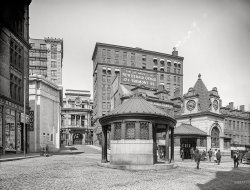
- Steel City: 1938
- ... Gallery, Arthur Rothstein, Boats & Bridges, Pittsburgh, Railroads) ... Posted by Dave - 05/02/2020 - 4:26pm -
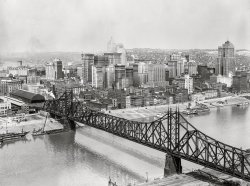
- When Chic Met Shabby: 1958
- ... opus. Although it used a narrower gauge than standard railroads it carried freight in addition to passengers. The Southern Pacific ... PE ran on standard gauge tracks, just like the steam railroads it interchanged freight cars with. And it was - from 1911 - a wholly ... Posted by Dave - 10/17/2019 - 9:14pm -
![When Chic Met Shabby: 1958 Somewhere around Los Angeles circa 1958. "Aluminum Group furniture (chairs, ottomans, tables) designed by Charles Eames for Herman Miller Inc." Large format negative from the Office of Charles and Ray Eames. View full size.
No Reading, No ParkingIt's the parking lot for the Christian Science Church Reading Room, currently located at 132 Brooks.
Nice FurnitureI guess I'll just sit down over here on the pavement.
PolaroidNote the Polaroid Land camera on the table at right. Frequently used for test shots made before the final large-format exposures.
The result?I was wondering what photos from this operation would look like. The shot at the foot of this 1959 print ad from eamesdesigns.com looks about right. http://eamesdesigns.com/library-entry/the-big-idea-in-herman-miller/
WarningIf you park in my reserved private spot, your furniture will be towed.
Charles and RayI think Charles Eames is the man standing with his foot on the ottoman and Ray Eames is the woman standing off to the side next to the lone chair with the jacket draped over it.
I love these chairs. I have two in my living room. Though designed in 1958 (originally intended as outdoor furniture), they are still in production today and seem to be everywhere on TV. For example, Jon Stewart's guests sit on them (the "secretarial" model).
[That is Ray Eames, at any rate. -tterrace]
Not That ShabbyThe roof on the left side is actually pretty chic. I suppose the dog was providing security.
Eames StudioSince the Eames Studio at that time stood at 901 Abbot Kinney Blvd in Venice, this shot was probably taken near the corner of Abbot Kinney Blvd and Main Street. Which would mean we're looking down Main, toward Hammond Lumber, which, as far as I've been able to discover, stood at 616 Main Street, in Venice, about where it ought to be in the photo.
Retro Love that old furniture. Note the stray dog on the side there.
[He's leashed to the bumper. - Dave]
This view was takenlooking north from Brooks Avenue. Holdren's Auto Service was at 165 Brooks, so the Eames studio was immediately east, as mamiyaman notes.
Who Framed Roger Rabbit has the answersThe rail spur leading into Hammond Lumber may seem out of place, as there aren't any train lines in the area. It's actually a spur off of the Pacific Electric streetcar line, also known as the Red Car system. Even today the right of way in Venice is still visible on aerial photos. Yes, the same Pacific Electric whose demise was a plot point in Mr. Rabbit's opus. Although it used a narrower gauge than standard railroads it carried freight in addition to passengers. The Southern Pacific Railroad operated the freight service under Pacific Electric's name.
Passenger service to Venice had ended several years before the date of this photo, but freight service continued until the early 1960's.
A Brilliant Collaboration! For an absolute treat don't miss...The American Masters Documentary on Charles & Ray Eames: "The Architect and the Painter".
Pacific ElectricPE ran on standard gauge tracks, just like the steam railroads it interchanged freight cars with. And it was - from 1911 - a wholly owned subsidiary of the Southern Pacific railroad.
PE was standard gauge,the LA railway (yellow cars)was 3 ft. 6" narrow gauge. They shared dual-gauge trackage for parts of their systems.
(Cars, Trucks, Buses, Charles & Ray Eames, Los Angeles, The Office)](https://www.shorpy.com/files/images/SHORPY-05385u.thumbnail.jpg)
- Montrose Newsies: 1940
- ... papers. (Remember them?)
(The Gallery, Bicycles, Kids, Railroads, Russell Lee, Small Towns) ... Posted by Dave - 09/13/2018 - 12:55pm -
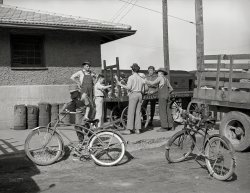
- Through to Morgantown: 1905
- ...
(The Gallery, Boats & Bridges, DPC, Pittsburgh, Railroads) ... Posted by Dave - 05/15/2017 - 3:33pm -
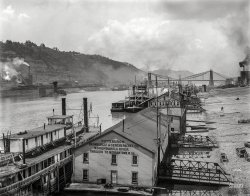
- The Bi-Pass: 1908
- ... adhesion.
Sound plausible?
(The Gallery, DPC, Railroads) ... Posted by Dave - 10/16/2011 - 9:35pm -
![The Bi-Pass: 1908 Holyoke, Massachusetts (vicinity), circa 1908. "The Bi-Pass, Mount Tom Railway." Here we see the railway's two "elevating cars," named after Rowland Thomas and Elizur Holyoke. 8x10 glass negative, Detroit Publishing Co. View full size.
Cable carI think it is a cable car, on an incline. The two cars counterbalance each other. The trolley pole probably is for lighting. Of bigger concern, if you look at the wheels, it appears to be derailed. Might be an illusion, but it sure looks like it is on the ties on the right side.
[The car has two sets of wheels -- inboard and outboard. - Dave]
Mechanically inclinedMaybe a traction fan can help me with my confusion here. We can see the trolley pole deployed, and we can see bonding wires running around the fishplate right in front of the car, so at first glance this looks like an electric system.
At second glance there are rollers immediately in front of the car and that middle cable looks like it's been gripped cable car style.
Is this some sort of mixed system with cable assist on the steep grades, or is it a cable system with auxiliary power for lights etc.?
Hybrid carsIt looks like it is electrically powered through the bypass area but otherwise a cable system.
It's unusualbut it appears to be an electric system with an auxiliary cable. The driver has his left hand on an early "K" series controller, which you wouldn't find on a cable car. The trolley wire hardware is also typical of a 600v electrification scheme, rather than simply for auxiliary power.
I see why the car has two sets of wheels - so it can negotiate the cable crossings in the passing loop, but I suspect they're only on the side closest to the camera. I'd assume the other car has them on the other side. The passing loops were most likely biased so that the cars always ran on one side only, which would also explain the twin trolley wire.
Dead Weight Balance
Science Abstracts, Royal Soc. of London, 1899.
Electric Railways of Springfield and Holyoke, Mass.
(Street Rly. Journ. 14. pp. 415-423, 1898.)
The Mount Tom mountain-line, which rises 700 ft. in 4,900 ft., with a maximum grade of 21½ per cent., is worked by two cars connected by a 1¼ in. cable over an 8 ft. return sheave at the upper end of the line. There are no winding engines to drive the cable, but each car is equipped with two G.E. 1,000 motors, the cable being used only to balance the dead weight in the cars.
The low wiresAs noted earlier in a related post, the wires down near the rails are for the motorman's telephone.
OperationThe type of car here is interesting in that only one set of wheels are double flanged. This is always the outside set of wheels, riding on the rail which does not break. The design allows the cars to make use of the "switching" system without need of actual pointwork; while at the same time pass over the running cable for the second car.
Mt. Tom operation explainedComments from H. Raudenbush:
I think I just figured it out. It definitely falls under the heading of a Austrian saying “Warum den einfach wenn komplizierte auch gehts” (Why make it simple when it can also be complicated)
It’s a counterbalanced trolley rig. Each car has traction motors, but the grade is too steep for normal adhesion working, so the cars are tied to the two ends of a cable. The cable must pass over a sheave at the top of the line, but unlike a funicular/incline, that sheave is not powered.
At the passing siding, the rope for one track has to cross rails of the other track. This is done crudely, by having a gap in the closure rail of the turnout. To get the car over this gap, the overhanging wheel is picked up by an auxiliary rail, which is probably higher than the normal rail. You can see the auxiliary rail beside the gap in the running rail.
The car hides the switch points or equivalent. Since the frog has flangeways, it appears that the normal wheels on both sides have normal flanges. (On some funiculars, each cars has double flanges on one side, no flanges on the other side. Then neither points nor frog are needed at the turnout).
You can see the cable attached to the near car, and the carrying sheaves for the cable along the track.
Those wires bracketed beside the track must have some function, but I’m not sure what. Possibly contacted by a shoe on the car, maybe they control the switch points. With the two cars at the ends of the cable, no signals are necessary (as long as the rope doesn’t stretch too much!)
That angle iron on a big timber in the middle of the track beside the cable, might be the equivalent of a Fell Rail, used for braking; brake shoes could clamp to it and provide braking independent of wheel-rail adhesion.
Sound plausible?
(The Gallery, DPC, Railroads)](https://www.shorpy.com/files/images/SHORPY_4a23777a.thumbnail.jpg)
- The Turning Point: 1910
- ...
(The Gallery, Cars, Trucks, Buses, Railroads, Travel & Vacation) ... Posted by Dave - 08/03/2012 - 4:06pm -
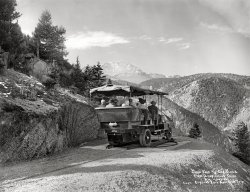
- Growth Spurt: 1912
- ... move).
(The Gallery, Boats & Bridges, DPC, Pittsburgh, Railroads) ... Posted by Dave - 08/29/2017 - 7:16am -
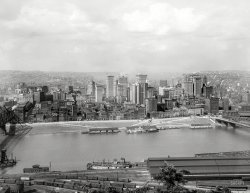
- Heavy Lifting: 1910
- ... I'm not sure which type.
(The Gallery, Cleveland, DPC, Railroads) ... Posted by Dave - 07/30/2012 - 10:41pm -
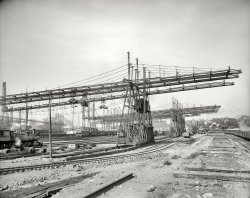
- The Braidwood Bunch: 1904
- ... between those two points.
(The Gallery, DPC, Railroads) ... Posted by Dave - 09/06/2016 - 7:04pm -
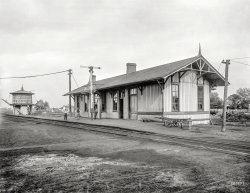
- All a Board: 1899
- ... here.
(The Gallery, DPC, Industry & Public Works, Railroads) ... Posted by Dave - 05/09/2016 - 5:12pm -
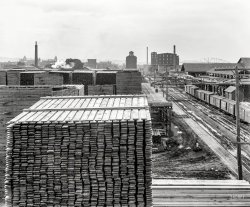
- Actually Eckman: 1938
- ... resemblance.
(The Gallery, M.P. Wolcott, Mining, Railroads, Small Towns) ... Posted by Dave - 04/08/2019 - 11:29am -
![Actually Eckman: 1938 September 1938. "Coal mining town of Welch [i.e., Eckman], in the Bluefield section of West Virginia." Photo by Marion Post Wolcott. View full size.
Bluefield section of WelchFatal Powder Blast
The Washington Post, District of Columbia
December 15, 1906
Bluefield, W. Va., Dec. 14. — An explosion at Eckman today of 10,000 pounds of powder, which was being transported on three mine cars from a freight car to the powder house of the Pulaski Company, resulted in the death of one, the fatal injury of two, and the serious injury of eight others. Three of the injured are women whose homes, near the scene of the explosion, were wrecked.
The dead:
Joseph Steel, 19, died on the way to the hospital
Fatally Injured:
Alex Finney, 36
Mrs. George Johnson
Seriously Injured:
Edward Mullin, 22
Felix Harduett
Mrs. Mary Forbes
T. Hairston
George Bland, 22
Oscar Cowns
C. W. Case
Mrs. Mary Rhoads
Wrecked Houses Take Fire
The wrecked houses took fire, and the scene was soon thronged with people. Timbers and empty powder cans were scattered over a large area.
The men were on the powder-laden cars and the women were in the houses nearby. The powder was in tins, and was moved from a freight car to the magazine, when sparks from the motor wheels or current from the motor set it off. The houses nearby were torn into splinters, and the detonation rocked the entire village. In a few minutes hundreds had congregated and engaged in fighting the fire, which broke out as soon as the explosion occurred. Some of the wounded were horribly burned, several of them lost their eyes, and the flesh hung in tatters from their bodies.
Note: According to the web site of the West Virginia Office of Miners' Health Safety and Training, this explosion killed 4 employees and 2 individuals on the surface near the mine.
Dichotomy Stunningly beautiful country up that way.
Absolutely dangerous and difficult way to live.
Going BOOM!About this time, a Mr Nobel realized that if you mixed highly volatile nitroglycerin with clay (or other inert substance) you created, what came to be named dynamite, which is so safe it take a strong primer to set it off. The E.I. duPont company began production and promoting it. The rest is safe blasting history.
[Check your facts. Alfred Nobel died in 1896. Dynamite was invented in the 1860s. - Dave]
EckmanAs Walter’s post would indicate and ex-N&W voices state, this photo location is of Eckman, WV.
Flatiron SouthIt seems one of Shorpy's favorite buildings had a son who settled in West Virginia. He is not as tall as dad but you can see the resemblance.
(The Gallery, M.P. Wolcott, Mining, Railroads, Small Towns)](https://www.shorpy.com/files/images/SHORPY-8c09387a.thumbnail.jpg)
- Garage à Trois: 1940
- ... least a panoramic simulation:
(The Gallery, Railroads, Russell Lee) ... Posted by Dave - 04/27/2020 - 9:58am -
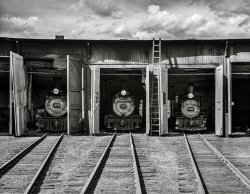
- Utility Boy: 1913
- ... is easier to judge by.
(The Gallery, Kids, Lewis Hine, Railroads) ... Posted by Dave - 09/28/2012 - 1:16pm -
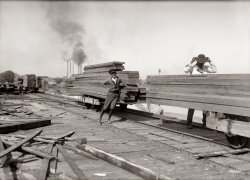
- Compleat Angler: 1901
- ... locomotive type.
(The Gallery, Boats & Bridges, DPC, Railroads) ... Posted by Dave - 04/12/2015 - 8:48am -
